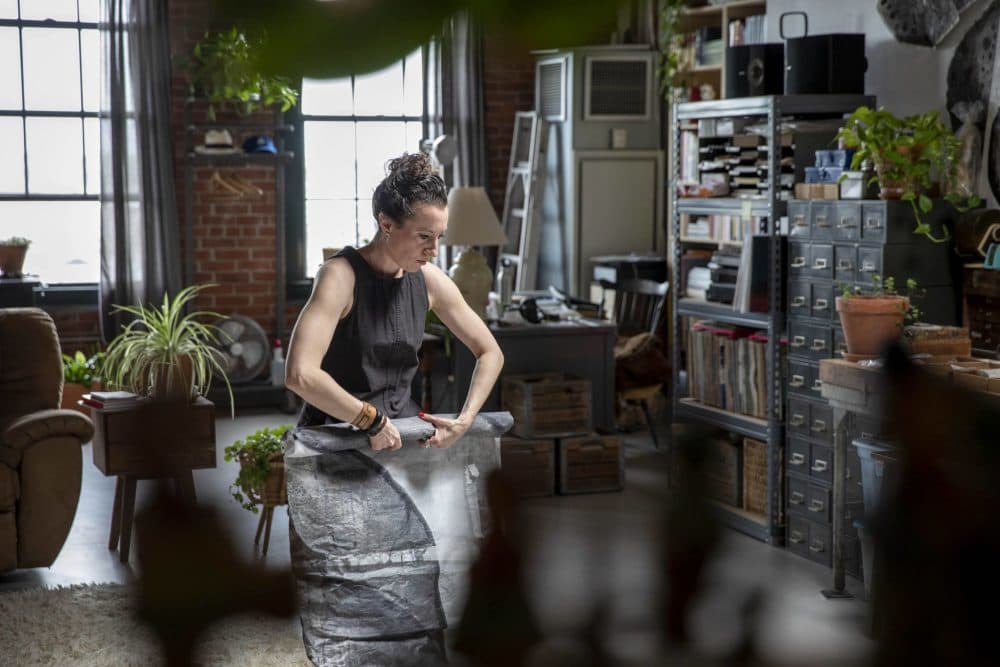
To fight displacement, artists are buying up Boston real estate
Kristen Mallia’s apartment in Fort Point is vast and sunny, with exposed brick walls and a lofty ceiling. Tall windows overlook the city. There is a nod to a living room, sketched out by couches and a rug, but otherwise the space is almost singularly devoted to Mallia’s work as an artist. What would, in most apartments, manifest as clutter is arranged with a collector’s precision. A huge draftsman’s table is organized with meticulous asymmetry: a notebook, a pyramid of empty picture frames, a pile of stones.
Mallia shows me around the apartment one afternoon. She first points out the kitchen, which is really just a wall of appliances. “And then this area is pretty much my workspace,” she says, gesturing at the rest of the apartment.
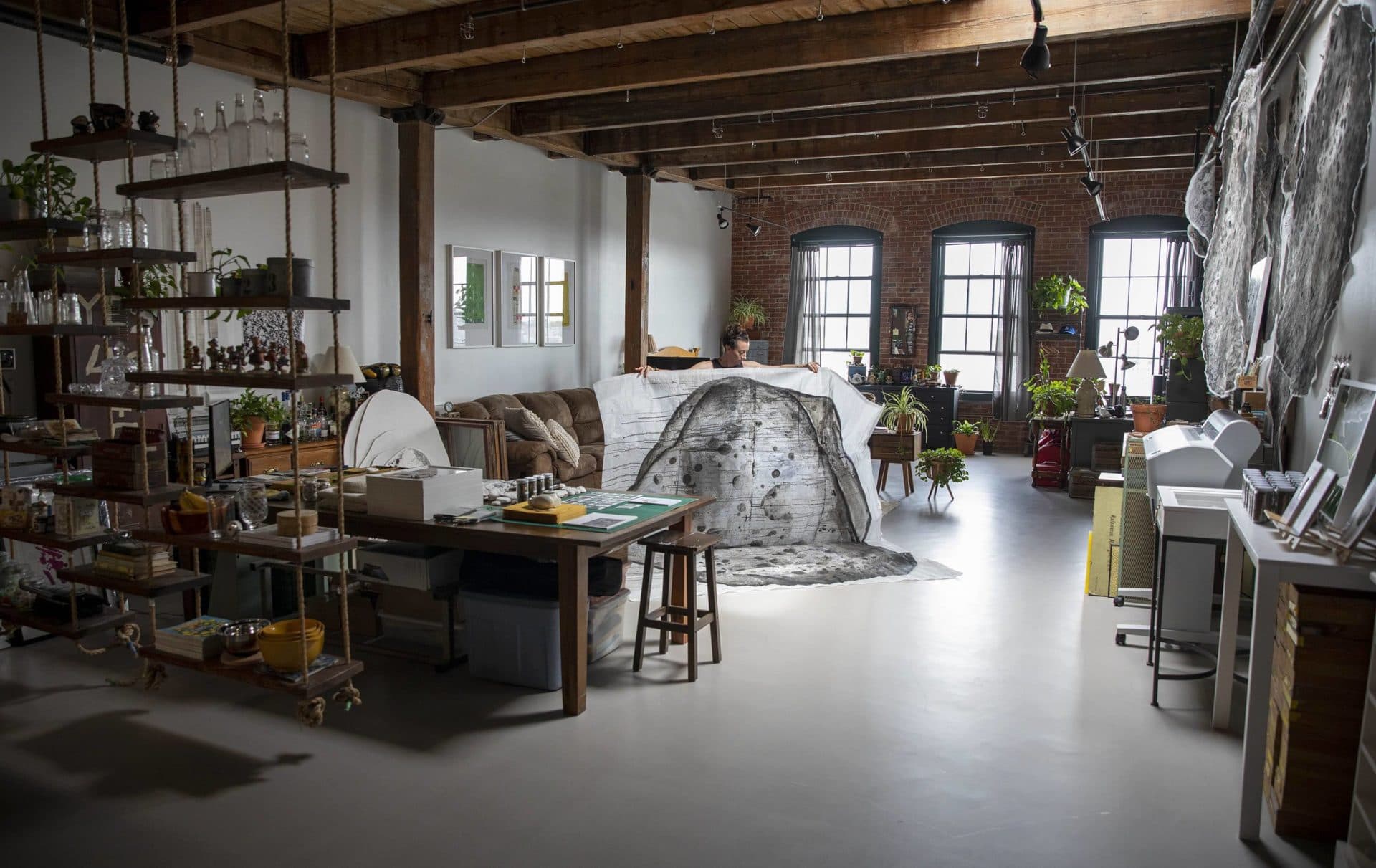
Mallia, an assistant professor of graphic design at Suffolk University, moved into her apartment at the end of 2020 after nearly two years on a waitlist. The sheer amount of space, she says, has made working on multiple projects immeasurably easier. She can spread out a painting on the floor, then switch to graphic design at her desk, then hop over to the draftsman’s table and (I imagine) spend hours rearranging its enchanting assortment of miscellanea to Instagram-worthy perfection — all without having to pack up one project to make room for the next.
Along one wall hangs a series of huge paintings, studies of volcanic rocks Mallia collected during a residency in Iceland. They look like pockmarked asteroids, rendered on translucent tracing paper in shades of black and gray. Such large pieces are a new venture for her, and only started after she moved into the studio. “I could finally start pushing scale with everything,” Mallia says.

Mallia’s live/work studio is one of 89 units in Midway Artist Studios, an artist collective that occupies three sprawling former wool warehouses at 15 Channel Center St. in Boston’s Fort Point neighborhood. The units are large, open and sturdy, adaptable to almost any use: painting, jewelry making, photography, dance. Thirty-six units are priced below market rate and reserved for residents who qualify through the city. Mallia says the rigorous process of qualifying, through the city, for her income-restricted apartment “wasn’t fun.” But, “I’d do it again in a second, obviously,” she says. “Whatever it takes to be in a space where I can be making what I want to be making.”
The unit comes with an even greater rarity in the city of Boston: security. Mallia doesn’t have to worry about getting priced out, or being displaced by a developer, because the building is owned and operated by the artists who live there.

This is what brought me to Midway Artist Studios. Its story is a novelty on the arts and culture beat, which is rife with tales of artist communities in crisis: the closure of beloved neighborhood music venues, the dwindling availability of affordable practice space, the destruction of decades-old artist communities to make way for luxury apartments. The drumbeat of disappearing cultural space is disheartening for anyone who cares about the arts — and perhaps to anyone who wishes for cities with local character rather than chain stores and banks. The Midway Artists Collective is one of the few artist groups that fought to gain control of its building, and won. I wanted to find out how.
The note under the door
Artists began moving into Fort Point in the 1970s, after the decline of the textile industry put the area’s huge wool warehouses up for grabs. Fort Point’s signature brick lofts, with their load-bearing floors and freight elevators, were attractive to artists, who made creative use of the rugged, well-lit spaces and a minimum of oversight. They built out the studios to fit their needs and, to cut costs further, sometimes lived illegally in the spaces. According to one city study, by 1995, artists occupied floors in 18 Fort Point buildings.
The late 1990s saw the beginning of a development boom, driving out artists in favor of office space and high-end residential projects. A few artist communities managed to stave off displacement by going co-op. In fact, that had been the original plan for the Midway Artist Studios, which were once owned by Bob Kuehn, a mission-driven real estate developer. He was instrumental in the creation of an artist co-op at another warehouse, on Summer Street, in 1995. But Kuehn’s unexpected death in 2006 passed the ownership of Midway to his estate and put the building’s future in limbo.
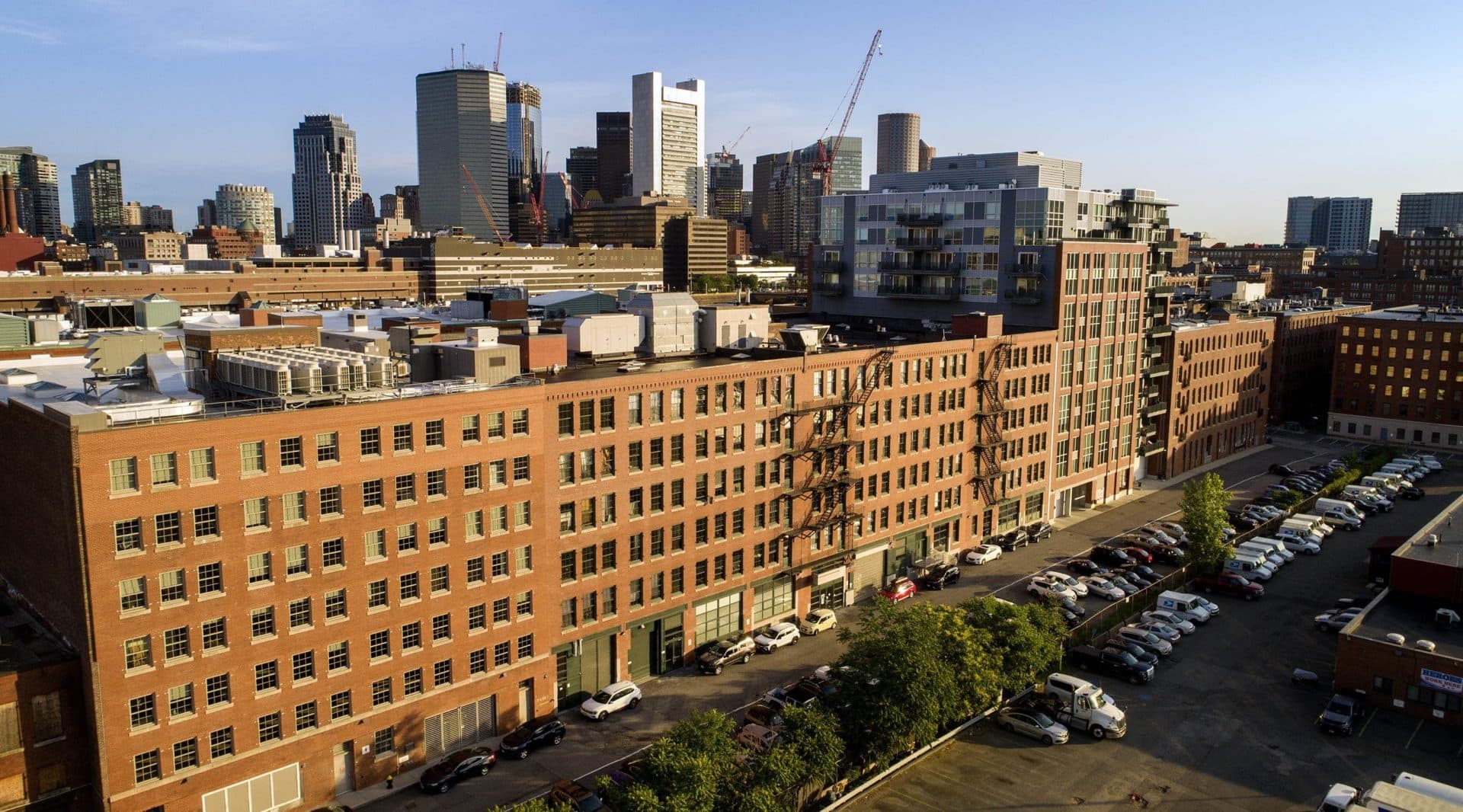
This was the context into which Raber Umphenour entered Midway in 2011. He and his wife had moved to Boston a short time before, only to be almost immediately displaced when their North End apartment building was redeveloped. The couple snagged a 1,100-square-foot studio at Midway, for which they paid about $1,500 a month. Umphenour, a filmmaker, and his wife, an architect, relished the community that came with a building full of artists. “You can share your ideas with them,” Umphenour says. “You can share your tools with them.”
The company that managed the building at the time communicated with tenants by slipping photocopied notes under their doors. Usually, these missives were mundane, related to routine building maintenance and the like. Umphenour would often let the notes accumulate. He remembers going through the pile one day in 2013.
“There was a note that said, ‘We want to inform you that … we intend to sell the building. Don’t worry, the sale will not affect you,’” Umphenour recalls, pausing for dramatic effect. “As soon as somebody says, ‘The sale will not affect you,’ I think that the first reaction is almost the exact opposite, which is: the sale definitely will affect you.”
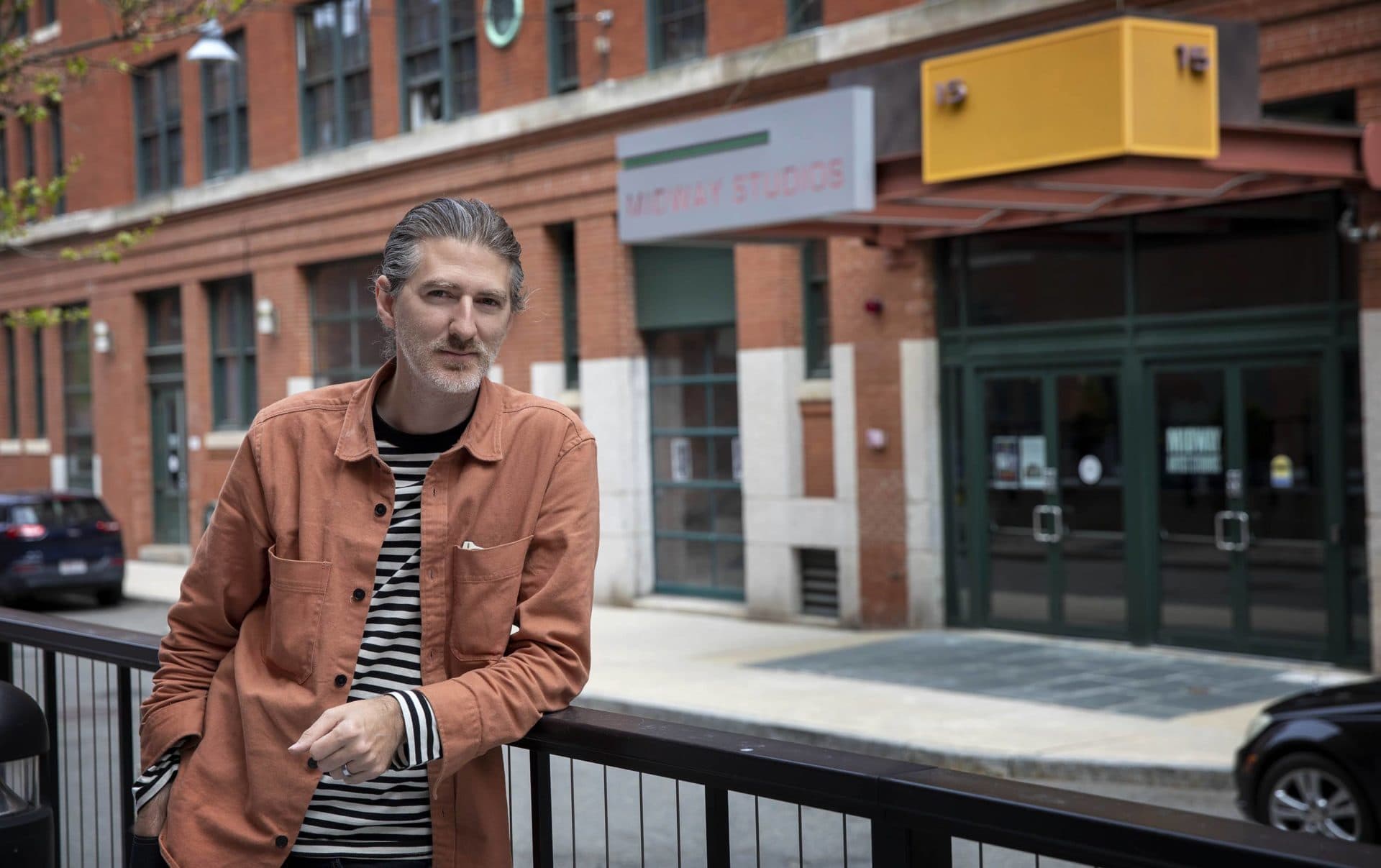
The panicked artists called a meeting. The idea was floated that perhaps they could collectively purchase the building. Umphenour and a few others started knocking on doors, asking residents how much money they could invest. They sweetened the deal by offering tenants a return on their investments: 8{7e5ff73c23cd1cd7ac587f9048f78b3ced175b09520fe5fee10055eb3132dce7} per year. According to Umphenour, within 72 hours they raised around $517,000.
These were all hypothetical commitments, of course. But it was enough to put together a bid. The artists decided on an amount they calculated would not require them to raise rents: $20 million.
“And the seller got back to us within a week and described it as ‘noncompetitive,’” Umphenour recalls.
This is the point in the story where you may find your assumptions about real estate transactions overturned. In Boston’s red hot housing market, it is common for buyers to pay above asking price, and for homes to go to the highest bidder. But it turns out that sellers can sometimes be persuaded. Bob Kuehn, who had also been a prominent figure in the worlds of affordable housing and historic preservation, had always intended the Midway building to go to the artists. His estate was amenable to that goal. Umphenour believes a letter-writing campaign and pressure from city councilors helped the artists’ case. In the end, they were able to convince Kuehn’s estate to enter into a purchase and sale agreement. But it came with a catch: the artists had to raise a $2.2 million down payment — in cash — in 14 business days.
“And thus began two weeks of constant stomach aches and raising $80,000 a day to try to get over the finish line,” Umphenour says.
The stakes, he explains, were high. “You were fighting for something that was not abstract. It was very concrete,” Umphenour says. “You were fighting for being able to preserve the community, the friendships, the livelihoods of your friends and neighbors and colleagues.”
The artists rallied. Some pulled money out of retirement accounts. People invested what they could, from as little as $1,000 up to $100,000. Outside investors chipped in, too. Implausibly, they were able to pull together the down payment in time. “I think that the seller was as surprised as we were,” Umphenour says.
With the down payment in hand, the artists set about securing the rest of the $20 million. They enlisted the aid of New Atlantic Development, a mission-driven firm that helped develop the Brookside Artist Studios, a mixture of affordable and market-rate live/work artist studios and condos in a former rubber factory in Jamaica Plain. Following the model New Atlantic used with Brookside, the Midway artists formed a nonprofit, Midway Artist Collective Inc., that would own the building and be controlled by a board elected in part by the artists. (Umphenour is a board member.) They decided to stick with rental units, rather than the more common co-op model, to keep the barrier to entry low. Tenants would not be required to invest, but those who did were promised a decent rate of return. The rest of the money was raised through outside investors, a grant from the city and low interest loans — primarily, a $14.5 million loan from Oppenheimer Multifamily Housing and Finance. The artists closed on the property in June 2014.
The arrangement, Umphenour says, has worked out better than anyone could have imagined. He estimates that the group is close to paying off the principal on investments from tenants and outside investors. He proudly touts the affordable rental units, which are supported entirely by income generated by the building with no help from outside subsidies. Even the apartments that are not income restricted are below market rate. (A 1,900-square-foot apartment at Midway goes for $2,900 — less than half the cost of a typical Seaport 3-bedroom.) “We really only want to raise rents to the extent necessary to support operating the building,” Umphenour says. “And that has translated into greater financial security for the whole community.”
Scaling up
I am always struck, when considering the story of Midway, by how many things went implausibly right for the artists — and how easily things could have gone wrong. What if the seller refused to accept a lower bid? What if the city had not been supportive? What if the artists couldn’t agree on a financial model? What if they failed to secure the rest of the funding? It is impossible to overstate the artists’ tenacity, commitment and ingenuity — but you can’t ignore the role of luck, either.
For Umphenour, their success hinged largely on the fundraising model, one that promised a decent return on investment but did not require everyone to invest. “We listened very, very carefully to what it was that people wanted,” he says. “And then we developed and built a very specific model, with the expertise of people we had engaged, to be responsive to those needs. As opposed to sort of supplanting that with what we thought was best.”
They undoubtedly benefited from the alliance with New Atlantic. The small firm has made an outsized impact on the arts scene in Boston, having developed a number of projects featuring affordable artist live/work studios and other cultural spaces. New Atlantic is in the final stages of securing a property in Dorchester on behalf of the artists at Humphreys Street Studios, in a similar deal to the one the firm helped facilitate for Midway.
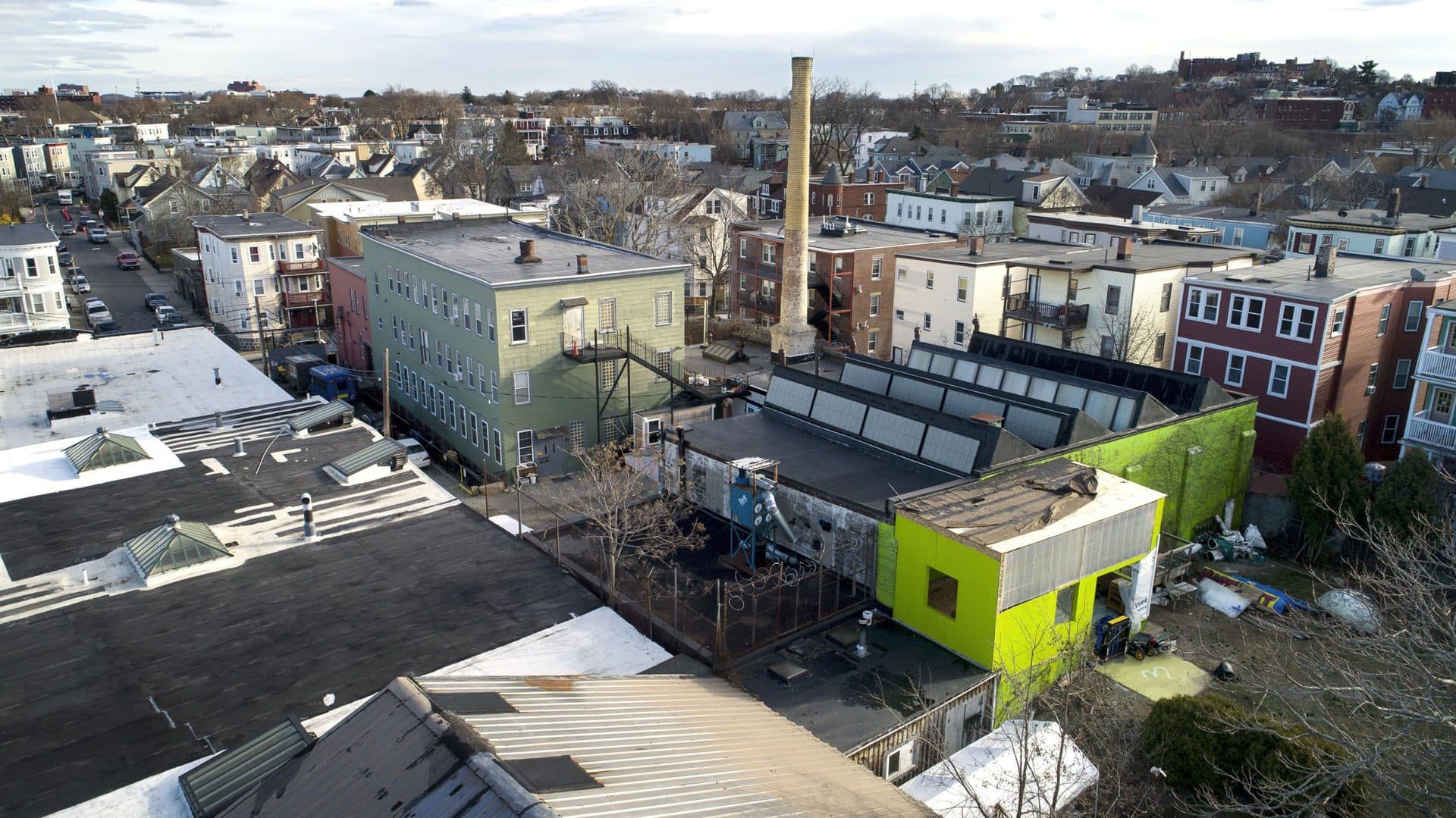
But there are limits to New Atlantic’s influence — not least because the developer is small. The company specializes primarily in affordable housing and leverages this expertise in the development of cultural spaces. This is the company’s strength — and perhaps its weakness. “I can develop or preserve artist live/work housing easily,” says New Atlantic founder Bill Hardy. “What I can’t do, and others can’t do, is really develop and preserve artist commercial workspace, because there are not the subsidy programs out there for commercial space.” That leaves out a whole category of artists who aren’t looking for housing but need space to work, rehearse or sell their wares.
Sometimes artists are reluctant to put their trust in a developer, especially when development is the very thing that threatens to displace them. “Real estate developers often kind of have a bad name,” Hardy says with a wry laugh. “There are reasons for that.”
All of which is to say that there is no easy way to replicate the Midway artists’ success — no tried-and-true recipe for buying your own artist building. But the need is clearly there. Artists wait for years for studios at Midway to open up. It begs an obvious question: do any programs exist to help secure arts space on a larger scale?
This question led me to San Francisco, where property acquisition has become something of a trend in the city’s cultural sector. The Community Arts Stabilization Trust, or CAST, is a leader in the field. In San Francisco, it is the organization artists turn to when their building goes on the market and they’re worried about getting priced out or evicted.
Moy Eng is CAST’s CEO. She tells me that the nonprofit was created in 2013 in response to a very similar set of conditions in San Francisco to the Boston of today. “[Real estate] was on the verge of becoming … prohibitively expensive,” in the early 2010s, Eng says. And with that came the fear that San Francisco’s artists and cultural organizations, “especially community-based, and small and mid-sized and BIPOC organizations,” would be priced out of the city.
CAST’s mission is straightforward: it acquires property on behalf of artists and cultural organizations and rents it back to them at an affordable rate. Very often, it helps them raise the capital to then buy back the property. A deed restriction ensures that the building will remain a cultural asset in perpetuity, even if the original buyer decides to sell. CAST has bought and renovated four cultural properties in San Francisco in the course of eight years, and is in the early stages of four more potential projects.
What CAST brings to the table is financial acumen and a laser-focused mission on preserving land for cultural use. Much like New Atlantic, they finance purchases using grants and low-interest loans. They also make use of New Market tax credits — a federal program designed to funnel investments into underserved communities that I have read about extensively and still have a hard time explaining. “It’s a complicated mechanism,” Eng assures me.
The model is not beyond critique. Noni Session, executive director of Oakland’s East Bay Permanent Real Estate Cooperative, or East Bay PREC, says that nonprofit land trusts, like CAST, “[tend] to cloister power … and the benefits of ownership among executive directors and boards” — which, in the United States, are overwhelmingly white.
East Bay PREC’s democratically-run co-op model takes a radical approach to investment, with a low interest rate of 1.5{7e5ff73c23cd1cd7ac587f9048f78b3ced175b09520fe5fee10055eb3132dce7} designed to bring down the cost of property acquisition. Investors and tenants share in the returns. “If your interest rate is at 6{7e5ff73c23cd1cd7ac587f9048f78b3ced175b09520fe5fee10055eb3132dce7}, a community cannot hold a project like that,” Session says. “They will spend the life of that project servicing the debt instead of servicing the community.” Though East Bay PREC has its roots in housing advocacy, the organization has begun to take on cultural projects. It recently purchased the long-shuttered Esther’s Orbit Room, once the hub of a thriving Black music scene in West Oakland, and plans to restore it to its former glory.
The strategy of both East Bay PREC and CAST rests on finding some “give” in the purchase price of property. “Either it’s got to be below market rate, or there are other mechanisms that make it possible so that the acquisition price is fair,” Eng says. Yes, she says, sometimes they get outbid — but less often than you’d think.

The need for an organization to help shore up cultural space in Boston has not gone unnoticed. In fact, former candidate for Boston mayor John Barros — who also served as Mayor Marty Walsh’s chief of economic development — pitched a very similar idea to CAST last year, in an essay in the Boston Globe. “Boston needs a new independent entity, the Boston Arts Development Agency, that is empowered to raise money, purchase property, and finance the acquisition and development of housing and commercial space,” Barros wrote.
After his defeat in the preliminary election, Barros reentered the private real estate sector as a managing principal for Cushman & Wakefield. And he returned to his idea of an organization that would acquire property in Boston for cultural use.
“Artists typically need an intermediary to help them either buy a property, redo a property, or refinance a property that would allow them to stay,” Barros says.
That’s where his organization would come in. Much like CAST, Barros’s nonprofit would help artists and cultural organizations buy property, or rent it to them at an affordable rate, preserving it for cultural use with deed restrictions. Barros also hopes the organization can act as a kind of liaison between artists and developers. “We need to work with developers so that we can maximize the development that’s happening in the city to make it appropriate for artists,” he says.
The project is not yet ready for a formal debut, but Barros says the funding is coming together. Once that happens, he can start buying up Boston real estate — for artists.
